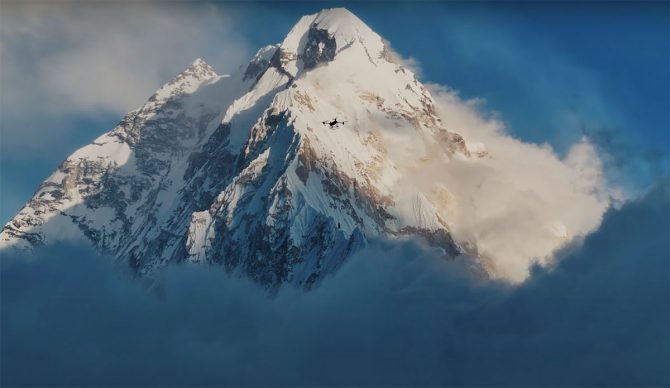
A DJI drone flew oxygen from the Mt. Everest Base camp to Camp 1 in a proof-of-concept test that might change how the world’s tallest peak is climbed. Photo: YouTube//Screenshot
In April of 2024, DJI did a drone test. It wasn’t any old drone test, though. They flew it from the Mt. Everest Base Camp to Camp 1 in a proof-of-concept test designed to show that drones could, in fact, be used to deliver supplies and cart away trash on the roof of the world.
The test was done in conjunction with Nepalese Airlift, a video production company called 8KRAW, and local guides. The drone used was a FlyCart 30, which is a workhorse of a drone capable of carrying up to 33 pounds. While helicopters could, in theory, make the flight, the dangers and costs are so high it’s not feasible.
“From the end of April, our team embarked on a groundbreaking endeavor to help make cleanup efforts on Everest safer and more efficient,” Christina Zhang, Senior Corporate Strategy Director at DJI, said. “We are thrilled to share that our DJI FlyCart 30 was up to the task. The ability to safely transport equipment, supplies, and waste by drone has the potential to revolutionize Everest mountaineering logistics, facilitate trash cleanup efforts, and improve safety for all involved.”
The DJI drone carried three oxygen bottles through the thin air above the base camp, which sits at 17,389 feet above sea level. Camp 1 sits at 19,685 feet, which is a height that the human body decidedly does not like. But carrying the supplies necessary for survival to those heights is not easy, to say the least, so having the help of a drone is a real boon to would-be climbers. On the way back, it took 33 pounds of trash with it.
“People who experience difficulty on this stretch of the mountain may find themselves in need of supplies and support until they can descend safely or until mountain rescue teams can find them,” IFLScience wrote. “So being able to deliver supplies via drones is an important step for improving the safety for mountaineers. But it also may help with efforts to clean up the mountain (every climber leaves an average of 8 kg (17.6 pounds) of waste as they ascend and descend).”
Mt. Everest is famously littered with trash. Bodies, too, but as of this writing, there isn’t a drone capable of carrying a body of a climber down. In general, the Sherpa guides have taken on the responsibility of transporting supplies or waste up and down the mountain, but it’s an exceedingly dangerous job. Camp 1 is just below the Khumbu Icefall, which is one of the more dangerous parts of summiting Everest.
“We need to spend 6-8 hours each day walking through this icefall,” Mingma Gyalje Sherpa, an Imagine Nepal mountain guide, explained in a statement. “Last year I lost three Sherpas. If we’re not lucky, if our time is not right, we lose our life there.”
Figuring out how to get a drone to not only fly, but to carry a load with it on Mt. Everest was a daunting task for the DJI team. Engineers needed to consider a variety of factors, including how a drone would operate in the brutal conditions. They subjected the FlyCart 30 in conditions that mimicked the ones it would encounter up there. Wind resistance, cold-weather performance, and weight capacity were all the focus of the tests, and once they realized that it was possible and they’d proven it, the Nepalese government decided to contract a local drone service company to set up a drone delivery operation on the southern slope of Everest.
If that contract is as successful as the test was, it will drastically change how Mt. Everest is summited — and hopefully will save lives in the process.

